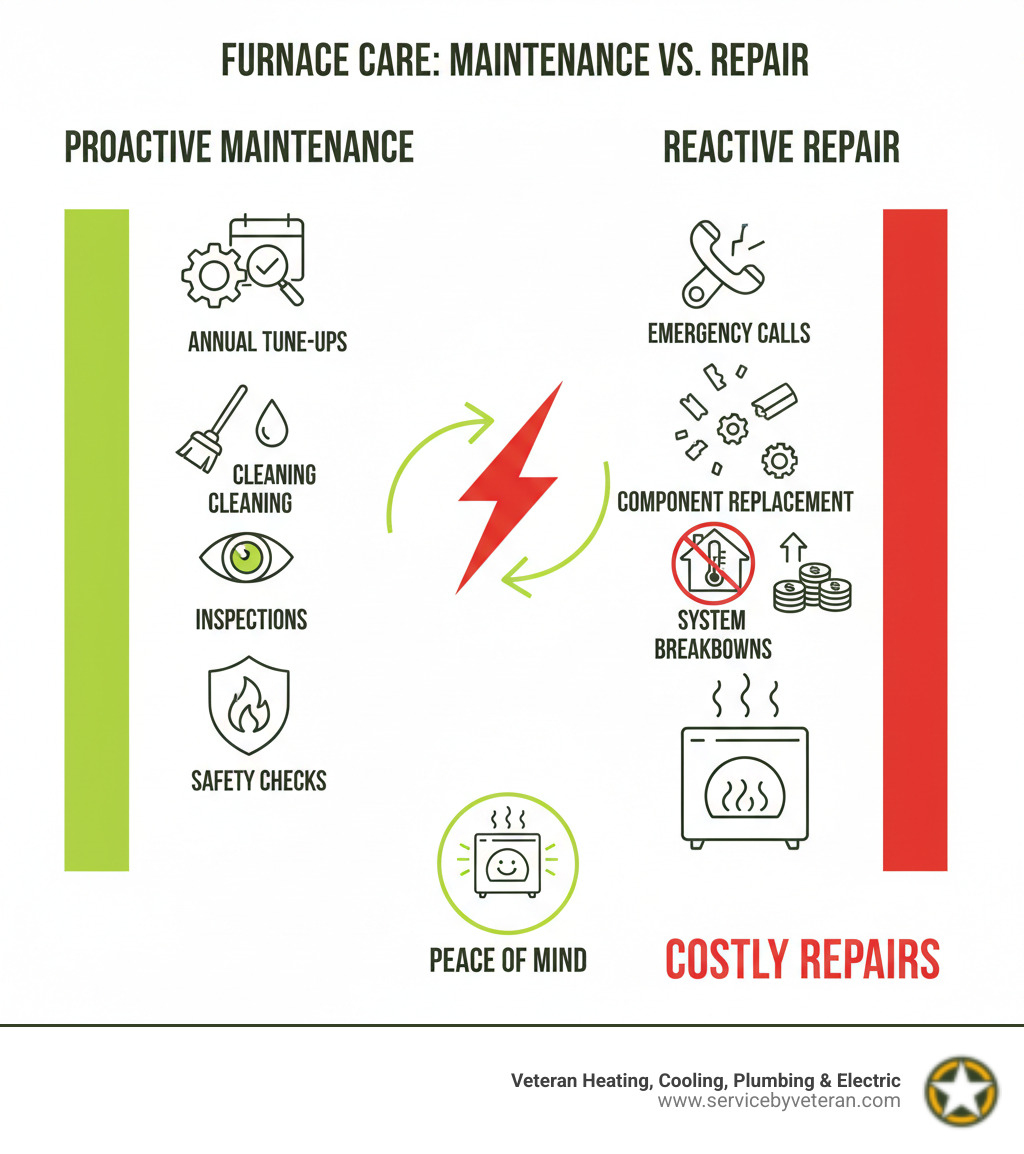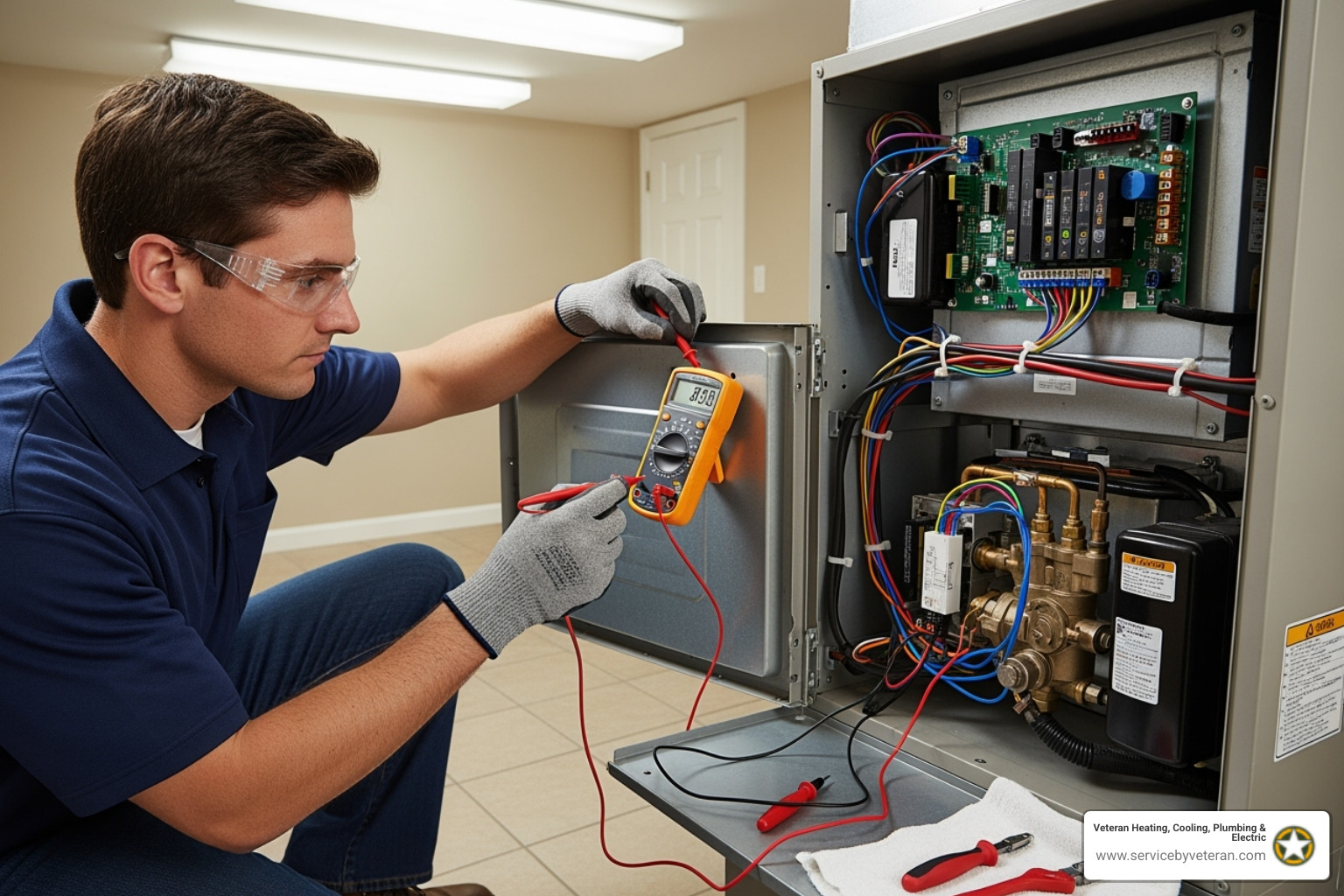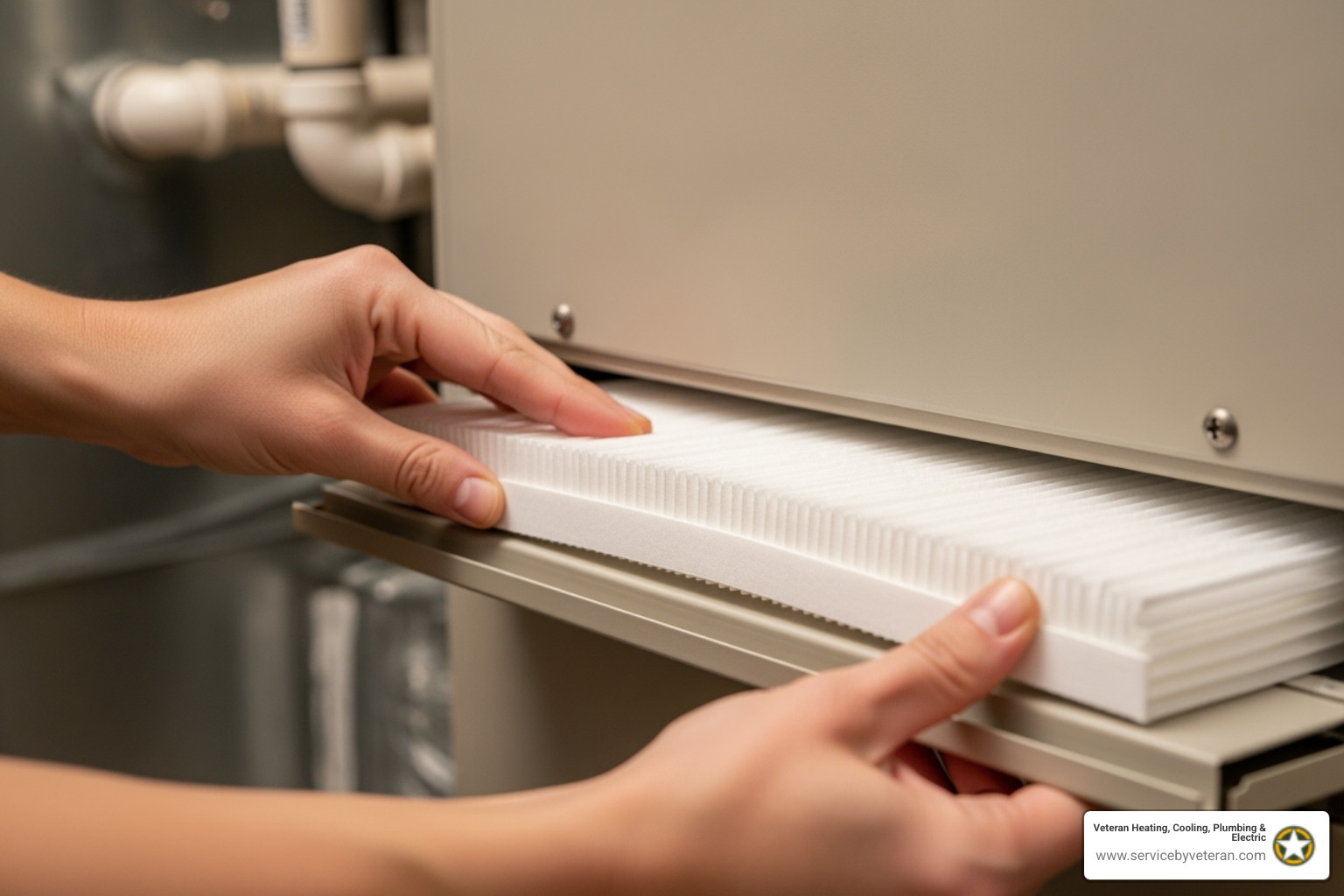
Beyond the Filter: What a Professional Furnace Service Entails
Why Proper Furnace Service Keeps Your Home Comfortable and Safe
Furnace service involves comprehensive maintenance, inspection, and tune-up procedures performed by certified technicians to ensure your heating system operates safely and efficiently. Here's what professional furnace service typically includes:
Key Components of Professional Furnace Service:
- Safety Inspections - Heat exchanger checks, carbon monoxide testing, gas leak detection
- Cleaning Services - Burner cleaning, blower wheel maintenance, debris removal
- Performance Testing - Igniter function, temperature rise measurements, airflow checks
- Preventive Maintenance - Filter replacement, lubrication of moving parts, thermostat calibration
- System Optimization - Gas pressure adjustments, electrical connection tightening, efficiency improvements
Most homeowners think changing the furnace filter is enough. But professional furnace service goes far beyond the basics. A typical tune-up involves checking dozens of components that most people never see or think about.
Regular maintenance can improve efficiency and extend your furnace's life expectancy, according to industry research. Annual service may also be required to keep your furnace warranty valid.
Your furnace works hard during cold months. Like any complex system, it needs professional attention to catch problems before they become expensive repairs or safety hazards.
I'm Mike Townsend, and my experience managing cooling systems for heat-seeking missile heads in the U.S. Army taught me that precision and attention to detail are critical for any heating system. That technical background now guides how I approach furnace service and help homeowners understand what proper maintenance really involves.

Maintenance vs. Repair: Understanding the Difference
Just like getting an oil change for your car to prevent engine failure, furnace maintenance is proactive care for your heating system. Understanding the difference between maintenance and repair can save you money and prevent a cold-weather breakdown.
Furnace maintenance is proactive care designed to prevent problems, while furnace repair is reactive, addressing issues that have already occurred. The cost difference is often dramatic. Regular maintenance helps catch small issues before they become expensive, emergency repairs. Skipping routine furnace service is a gamble that your system won't fail during the coldest week of the year.
Proactive upkeep not only extends your furnace's lifespan but is also often required to keep your manufacturer's warranty valid.
What is Furnace Maintenance?
Furnace maintenance is a comprehensive, scheduled preventative care visit for your heating system. During this tune-up, our certified technicians perform a detailed inspection and cleaning of all components.
This goes far beyond changing a filter. A proper maintenance visit includes critical safety checks to protect your family from hazards like carbon monoxide leaks. We test electrical connections, calibrate your thermostat, and verify that every component is working correctly.
The efficiency optimization we perform can lower your monthly utility bills, as a clean, well-tuned furnace uses less energy. This proactive approach helps us spot and fix potential problems early, preventing breakdowns when you need heat the most.
What is Furnace Repair?
Furnace repair is what happens when prevention didn't work or maintenance was skipped. This is our emergency service to address malfunctions and get your heat back on.
Common repairs include replacing broken parts like a faulty igniter or blower motor, or fixing a malfunctioning thermostat. While some fixes are simple, others can be complex and costly.
The cost difference is significant. Minor repairs might run $50 to $150, but major issues can easily exceed $1,200. Compared to the cost of annual maintenance, prevention makes clear financial sense.
Emergency repairs during peak winter months often come with higher costs and longer wait times due to high demand. If you're currently facing a breakdown, you can find more info about furnace repair services to understand your options.
What a Professional Furnace Tune-Up Actually Includes
When you schedule a professional furnace service, you're investing in a thorough health check performed by certified technicians. Our team uses specialized diagnostic tools and follows a detailed checklist covering safety, cleaning, and performance optimization to ensure your system is safe, efficient, and ready for winter.

Precise measurements of components like igniters and capacitors help us spot potential failures before they leave you in the cold. This careful process ensures your system is safe, efficient, and ready to keep your family comfortable all winter long.
The Inspection Phase: A Health Check for Your Heater
This phase is a complete exam to catch warning signs early.
- Heat exchanger inspection: Our top priority is inspecting the heat exchanger for cracks or corrosion that could leak dangerous carbon monoxide.
- Burner and flame sensor check: We check the burners and flame sensor for proper function. A blue pilot light indicates clean combustion, while a yellow flame signals a problem. We also clean the flame sensor, a common cause of furnace shutdowns.
- Electrical connection check: We tighten all electrical connections and check for wear or corrosion to prevent performance issues and safety hazards.
- Thermostat calibration: We calibrate the thermostat to ensure it reads temperatures accurately, preventing uneven heating and wasted energy.
- Safety controls test: We test all safety controls, like limit and pressure switches, to ensure your furnace's built-in protection systems are working.
- Flue and vent system check: We inspect the flue and vent system for blockages to ensure combustion gases are safely expelled outside.
The Cleaning Phase: Restoring Peak Efficiency
Removing built-up dirt and debris helps your system run efficiently.
- Cleaning the burners: We clean the burners to ensure clean, efficient combustion, which saves energy and improves safety.
- Cleaning the blower wheel: We carefully clean the blower wheel, which moves warm air through your home. Removing dust and grime improves airflow significantly.
- Removing debris from the cabinet: We vacuum debris from the burner and blower compartments to improve airflow and reduce fire hazards.
- Cleaning the flame sensor: A dirty flame sensor can prevent your furnace from staying lit. We clean it so it can accurately detect the flame.
- Clearing the condensate drain: For high-efficiency furnaces, we clear the condensate drain line to prevent blockages, water damage, and system shutdowns.
The Testing & Adjustment Phase: Fine-Tuning Performance
After inspection and cleaning, we fine-tune your furnace for peak performance.
- Testing the igniter function: We test the igniter's function and measure its electrical resistance (45-100 ohms is typical) to confirm it's working correctly.
- Measuring temperature rise: We measure the temperature rise (the difference between air entering and leaving the furnace) to verify it's heating effectively.
- Checking gas pressure: We check that gas pressure meets manufacturer specifications for safe, efficient combustion.
- Carbon monoxide testing: We perform carbon monoxide (CO) testing in the flue and at vents to ensure no CO is entering your living space—a critical safety check.
- Lubricating moving parts: We lubricate moving parts like the blower motor to reduce friction and prevent premature failure. We also check the motor capacitor, as a failing one can cause the motor to struggle or not start.
The Payoff: Why Regular Furnace Service is a Smart Investment
Regular furnace service isn't an expense—it's an investment that saves you money. By keeping your system in top condition, you're making a smart financial decision that pays off in multiple ways.
A clean, well-tuned furnace has improved energy efficiency, using less fuel to produce the same amount of heat. This translates directly to lower utility bills all winter long. Perhaps the biggest payoff is an extended furnace lifespan. Annual service can add years to your system's life, saving you thousands on a premature replacement.
Beyond savings, you'll enjoy improved home comfort with more consistent heating and fewer cold spots. Most importantly, regular maintenance provides improved safety and peace of mind, knowing your system is free of hazards like carbon monoxide leaks and won't fail when you need it most.
How Furnace Service Impacts Energy Efficiency and Lifespan
A dirty furnace can use up to 15% more energy than a clean one. When we perform furnace service, we restore your system to optimal performance.

This reduced strain on components is key to longevity. By keeping parts clean and adjusted, we help them operate as designed, preventing premature failure. We've seen annually serviced furnaces run reliably for 15-20 years, while neglected systems often require major repairs or replacement in just 8-10 years.
This proactive approach leads to fewer costly repairs. Spotting issues during routine service prevents them from escalating into expensive emergency calls. To make this process easier, consider our More info about our Maintenance Plans, designed to maximize your long-term savings.
Protecting Your Home and Warranty
Professional furnace service does more than keep you comfortable—it keeps you safe.
Preventing CO leaks is a top priority. Carbon monoxide is a colorless, odorless, and deadly gas. We carefully inspect your heat exchanger for any cracks or damage that could allow CO to enter your home and test CO levels to ensure proper venting.
Fire hazard reduction is another critical benefit. Our cleaning and inspection process eliminates risks from dust buildup, frayed wiring, or blocked vents.
Many homeowners don't realize that validating manufacturer warranty often requires proof of annual professional maintenance. If you skip service, you could be forced to pay out-of-pocket for a repair that should have been covered.
We provide a documented service history for every visit, giving you the proof needed to uphold your warranty agreement. This documentation can save you thousands if a major component fails while under warranty.
The Big Decision: Repair or Replace Your Furnace?
Every homeowner eventually asks: Should I repair my furnace again, or is it time to replace it? Understanding a few key factors can help you make the right choice for your home and budget, especially when a heater fails in winter.
| Factor | Repair Generally Favored | Replace Generally Favored |
|---|---|---|
| Age of Furnace | Under 10-15 years old | Over 15-20 years old (gas), over 20-30 years old (electric) |
| Frequency of Repairs | Infrequent, minor issues | Frequent, recurring breakdowns |
| Repair Cost | Less than 50% of replacement cost, minor component repair | More than 50% of replacement cost, major component failure |
| Energy Bills | Consistent, manageable | Noticeably increasing, high |
| System Efficiency (AFUE) | High AFUE (80% or more) | Low AFUE (below 80%), especially older units (50-70% efficient) |
| Warranty Status | Still under warranty | Warranty expired, no coverage for parts/labor |
| Home Comfort | Consistent, even heating | Uneven heating, cold spots, thermostat issues |
| Safety Concerns | No major safety issues (e.g., CO leaks) | Recurring safety concerns (e.g., pilot light, heat exchanger cracks) |
Furnace age isn't the only factor. It can be practical to repair a 15- to 20-year-old furnace unless a new, high-efficiency model offers substantial savings. A well-maintained gas furnace typically lasts 15-20 years, but if yours requires frequent repairs, is driving up energy bills, or has a low efficiency rating (some older units are only 50% efficient), replacement is often the smarter long-term investment.
Signs You Need Professional Furnace Service
Your furnace will often signal when it needs attention. Calling for furnace service when you notice these signs can prevent a major breakdown.
- Strange noises: Banging, rattling, or squealing sounds are not normal and often indicate loose parts or a failing motor.
- Uneven heating: If some rooms are warm while others are cold, your furnace may be struggling with airflow or balance.
- Increased energy bills: A sudden spike in heating costs often means your furnace has lost efficiency and is working too hard.
- Yellow or flickering pilot light: A pilot light should be blue. A yellow flame indicates a problem, potentially a dangerous carbon monoxide issue, that needs immediate professional attention.
- Short cycling: When your furnace turns on and off in frequent, short bursts, it can be a sign of a clogged filter, an improperly sized unit, or a failing component.
- Poor airflow: Weak airflow from vents can indicate a problem with the blower motor, filter, or ductwork.
- Unusual smells: Burning odors or the smell of natural gas require immediate action. If you smell gas, evacuate your home and call your gas company and an HVAC technician from a safe location.
Repair Costs vs. Replacement Costs
Understanding the financials helps with the repair-or-replace decision. Furnace repair costs vary widely.
Minor repairs like cleaning a sensor may cost $50-$150, while more common repairs are $150-$300. Major issues like a heat exchanger or blower motor replacement can exceed $1,200. You can find more details on typical furnace repair costs from industry sources.
A good rule of thumb: if repair costs approach 50% of a new furnace installation, replacement often makes more financial sense. A new furnace installation typically ranges from $2,900 to $6,400, with many gas furnace projects falling between $4,000 and $10,000.
While the upfront cost is higher, modern high-efficiency units (90%+ AFUE) deliver significant long-term savings on energy bills compared to older models, justifying the investment. We offer flexible options on our Financing Page to help make this upgrade more manageable.
Frequently Asked Questions about Furnace Maintenance
Homeowners often have similar questions about furnace service. Here are answers to the most common ones.
How often should a furnace be serviced by a professional?
We recommend professional furnace service once a year, every year. This preventive care catches problems before they become emergencies. The best time for a tune-up is in the fall, before the heating season begins, so you can address any issues before you're left in the cold.
While some newer furnaces might be fine every other year, annual service is the best way to ensure reliability, efficiency, and safety. Yearly service is also typically required to keep your furnace's warranty valid.
What are the signs of a malfunctioning furnace that require immediate attention?
Some furnace problems are emergencies. Call for immediate service if you notice any of the following:
- Smell of gas: Evacuate your home immediately without touching any electronics or light switches. Call your gas company and an HVAC professional from a safe distance.
- No heat during freezing weather: This is an emergency that can lead to frozen pipes and put your family's safety at risk.
- Persistent loud noises: Grinding, banging, or screeching can signal an imminent catastrophic failure.
- Carbon monoxide detector alarm: This is the most serious warning. Get everyone out of the house immediately and call 911.
- A yellow or flickering pilot light: This indicates incomplete combustion and can produce carbon monoxide, requiring immediate professional attention.
Can homeowners perform some basic furnace maintenance tasks themselves?
Yes, while professional furnace service is essential, homeowners can perform a few key tasks to help maintain their system.

- Change your furnace filter: This is the most important DIY task. Check the filter monthly and replace it every 1-3 months. A dirty filter restricts airflow and makes your furnace work harder.
- Keep vents and registers clear: Ensure furniture, rugs, and other items are not blocking airflow from your vents.
- Maintain clear space around your furnace: Keep the area around your furnace clear of stored items (at least three feet of clearance) for safety and proper airflow.
- Check your thermostat: Ensure it has fresh batteries and is functioning correctly. Sometimes a simple thermostat issue can seem like a furnace problem.
These tasks complement, but do not replace, your annual professional furnace service.
Stay Warm and Safe with Professional Care
When winter arrives in Colorado, your furnace becomes the unsung hero of your home. As we've explored throughout this guide, furnace service is far more than a quick filter swap—it's your insurance policy against cold nights and costly surprises.
The benefits of proactive furnace service create a ripple effect throughout your home and budget. Your energy bills stay manageable because a well-tuned furnace doesn't have to work overtime. Your family stays comfortable with consistent, even heating that eliminates those annoying cold spots. Most importantly, you sleep better knowing your heating system is operating safely, without the risk of carbon monoxide leaks or other hazards.
Think of it this way: you wouldn't skip oil changes for your car and expect it to run smoothly for years. Your furnace deserves the same attention and care. Regular maintenance prevents those middle-of-the-night breakdowns when temperatures plummet and repair costs skyrocket.
At Veteran Heating, Cooling, Plumbing & Electric, we understand that your home is your sanctuary. That's why we bring military precision and community values to every service call. As a veteran-led, locally owned company serving Denver, Lakewood, Littleton, Wheat Ridge, Aurora, Westminster, Arvada, Castle Rock, and surrounding Colorado communities, we're not just your HVAC contractor—we're your neighbors.
Our commitment goes beyond just showing up. We back every job with a lifetime warranty on parts and labor and offer a money-back guarantee because we believe in doing the job right the first time. When you choose us for your furnace service, you're choosing honest, personal service from people who care about your comfort and safety.
Don't wait until your furnace decides to take an unscheduled vacation during the next cold snap. Let our certified technicians give your heating system the professional attention it deserves. Explore our comprehensive heating services and schedule your tune-up today. Your future self—and your wallet—will thank you.
Where we go
SERVICE AREAS
We proudly serve a wide range of homes and businesses with fast, reliable HVAC, plumbing, and electrical solutions.
Arvada


